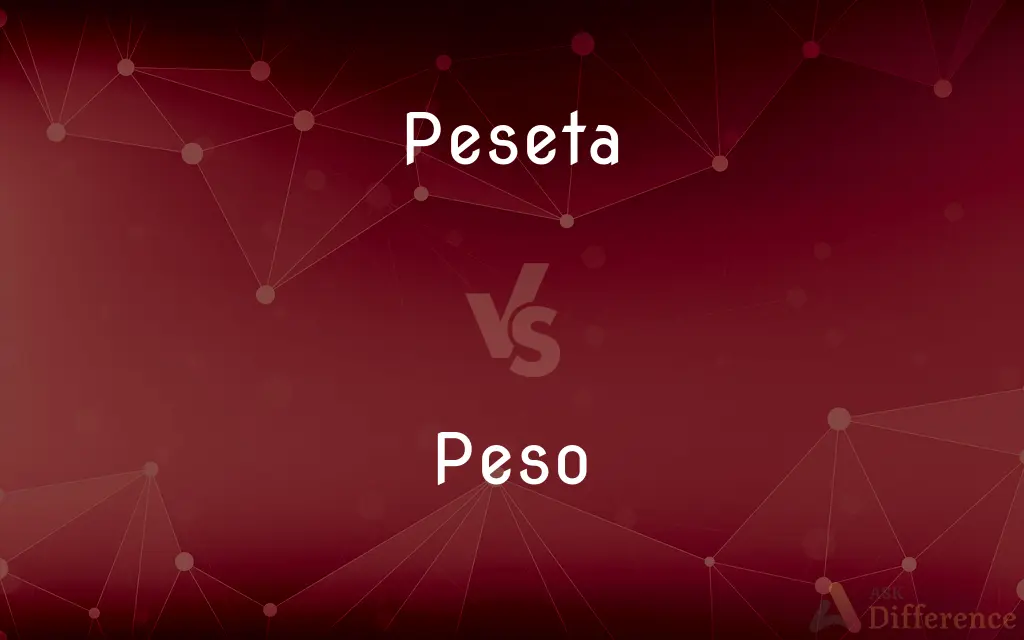Peseta vs. Peso — What's the Difference?
Edited by Tayyaba Rehman — By Maham Liaqat — Updated on April 15, 2024
The peseta was the former currency of Spain, replaced by the euro in 2002, while the peso is used in various Latin American countries and the Philippines.

Difference Between Peseta and Peso
Table of Contents
ADVERTISEMENT
Key Differences
The peseta served as the official currency of Spain from 1869 until its replacement by the euro in 2002, symbolizing Spain's economic history and transition. In contrast, the peso is currently the official currency of countries like Mexico, Argentina, and the Philippines, each with distinct versions and values.
While the peseta was phased out due to Spain's entry into the Eurozone, the peso remains actively in use, reflecting the independent monetary policies of countries that have retained this currency despite global pressures towards currency consolidation.
The denominations of the peseta were issued in coins and banknotes, which ceased being legal tender after the transition to the euro. On the other hand, peso currencies are still actively minted and circulated in their respective countries in various denominations suited to local economies.
Historically, the peseta was introduced to modernize and unify Spain's monetary system post its alignment with the Latin Monetary Union. Meanwhile, the peso has roots going back to the Spanish dollar, which influenced many currency systems worldwide.
Economically, the discontinuation of the peseta marked Spain’s integration into a larger, shared economic framework of the Eurozone aimed at economic stability and growth. The peso, however, continues to be influenced by national economic conditions, such as inflation rates and monetary policy decisions in its respective countries.
ADVERTISEMENT
Comparison Chart
Country
Spain
Mexico, Argentina, Philippines, etc.
Replaced by
Euro (2002)
Still in use
Denominations
Coins, Banknotes (no longer used)
Coins, Banknotes (actively used)
Historical Origin
Latin Monetary Union (1869)
Spanish dollar (16th century)
Economic Role
Unified national currency
Varies widely by country, independent policies
Compare with Definitions
Peseta
Former currency of Spain, divided into 100 céntimos.
He saved old pesetas as souvenirs from his trip to Spain.
Peso
Currency used in several Latin American countries and the Philippines.
When traveling in Mexico, you need to exchange your money for pesos.
Peseta
Introduced in 1869, replaced by the euro in 2002.
My grandmother often calculated prices in pesetas out of habit.
Peso
Derived from the Spanish dollar, historically widespread.
The peso's design was influenced by the Spanish dollar, once a global currency.
Peseta
No longer legal tender after the adoption of the euro.
Tourists occasionally find pesetas, which are now collector's items.
Peso
Subject to local economic fluctuations.
The Argentine peso has experienced significant inflation in recent years.
Peseta
Symbol of Spain’s historical economic phase.
Museums display pesetas to illustrate Spain’s monetary history.
Peso
Key part of national identity in countries where used.
The Philippine peso features national heroes and cultural symbols.
Peseta
Associated with Spain’s modernization efforts.
The introduction of the peseta was a major step in modernizing Spain's economy.
Peso
Continuously minted and circulated.
New peso coins were issued last year to replace old ones.
Peseta
The primary unit of currency in Spain and Andorra before the adoption of the euro.
Peso
The peso is the monetary unit of several countries in the Americas and the Philippines. Originating in Spain, the word peso translates to "weight" and uses the peso sign ("$"; "₱" in the Philippines).
Peseta
The former currency of the Spanish Empire and Andorra, divided into 100 céntimos.
Peso
Abbr. p. See Table at currency.
Peseta
The Equatorial Guinean peseta, a former currency of Equatorial Guinea
Peso
A silver coin that was formerly used in Spain and Spanish America; a piece of eight.
Peseta
The Sahrawi peseta, de jure currency of the Sahrawi Arab Democratic Republic.
Peso
(historical) A former unit of currency in Spain and Spain's colonies, worth 8 reales; the Spanish dollar.
Peseta
The Catalan peseta, a former currency of Catalonia.
Peso
The circulating currency of various Spanish-speaking American countries (Argentina, Chile, Colombia, Cuba, the Dominican Republic, Mexico, and Uruguay) and the Philippines.
Peseta
A Spanish silver coin, and money of account, equal to about nineteen cents, and divided into 100 centesimos.
Peso
A Spanish dollar; also, an Argentine, Chilian, Colombian, etc., coin, equal to from 75 cents to a dollar; also, a pound weight.
Peseta
Formerly the basic unit of money in Spain; equal to 100 centimos
Peso
The basic unit of money in Uruguay; equal to 100 centesimos
Peso
The basic unit of money in the Philippines; equal to 100 centavos
Peso
The basic unit of money in Mexico; equal to 100 centavos
Peso
The basic unit of money in Guinea-Bissau; equal to 100 centavos
Peso
The basic unit of money in the Dominican Republic; equal to 100 centavos
Peso
The basic unit of money in Cuba; equal to 100 centavos
Peso
The basic unit of money in Colombia; equal to 100 centavos
Peso
The basic unit of money in Chile; equal to 100 centesimos
Common Curiosities
What countries currently use the peso?
Countries using the peso include Mexico, Argentina, Colombia, and the Philippines.
Are pesetas still legal tender in Spain?
No, pesetas ceased to be legal tender after the transition to the euro.
How does the value of different peso currencies compare?
The value varies significantly due to different economic conditions in each country.
Can you exchange old pesetas for euros today?
Yes, but only at the central bank of Spain and until a specified deadline.
How does inflation affect the value of the peso?
High inflation rates can devalue the peso, as seen in some Latin American countries.
What are the economic implications of using the peso in multiple countries?
It highlights the independent economic policies and conditions of each country.
What denominations were available for the peseta?
The peseta was available in both coins and banknotes.
What historical impact did the Spanish dollar have on the peso?
It influenced the monetary systems of various countries, leading to the adoption of the peso.
When was the peseta officially replaced by the euro?
The peseta was replaced by the euro in 2002.
What was the purpose of introducing the peseta?
To modernize and unify the Spanish monetary system.
How do tourists manage currency in peso-using countries?
Tourists typically exchange their home currency for pesos upon arrival.
What are some collectible forms of the peseta?
Collectors often seek out old peseta coins and banknotes for their historical value.
Why is the peso still important in countries that use it?
It plays a crucial role in the national economies and everyday transactions.
What lessons can be learned from the economic history of the peseta?
It illustrates the benefits and challenges of transitioning from a national currency to a shared currency like the euro.
How are new peso designs decided?
They are typically decided by national banks and often incorporate cultural and historical themes.
Share Your Discovery

Previous Comparison
Umm vs. Erm
Next Comparison
Pomelo vs. OroblancoAuthor Spotlight
Written by
Maham LiaqatEdited by
Tayyaba RehmanTayyaba Rehman is a distinguished writer, currently serving as a primary contributor to askdifference.com. As a researcher in semantics and etymology, Tayyaba's passion for the complexity of languages and their distinctions has found a perfect home on the platform. Tayyaba delves into the intricacies of language, distinguishing between commonly confused words and phrases, thereby providing clarity for readers worldwide.
















































